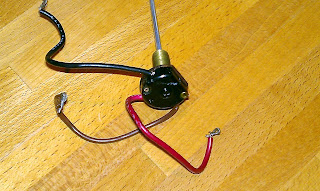 |
| The left side shows the "before"... |
 |
| ...and "after" |
 |
| Before |
 |
| After |
Kari deciphered the wiring, but in the process the 2-circuit rotary switch was broken and one of the soldered connections in the switch broke off as well. I was able to solder the wire to its strike plate and reinsert in the rotary switch. Then I super glued the switch back together. Kari finished the wiring, we soldered new connections, and then reassembled the lamp.
We opted for a new brown cloth covered cord and a new plug-in. Once everything was assembled we ran the cord through the original weight so we can adjust the height of the lamp and wired the plug. Then we measured out the perfect place on the living room wall.







3 comments:
You have way more patience than I have. Great job!
I just LOVE it, when you can sit down and look at a really well finished project! Your patience amazes me. Is it all wood or wood and glass?
Thanks! The little veneer cutouts are wood and the other part is fiberglass.
Post a Comment